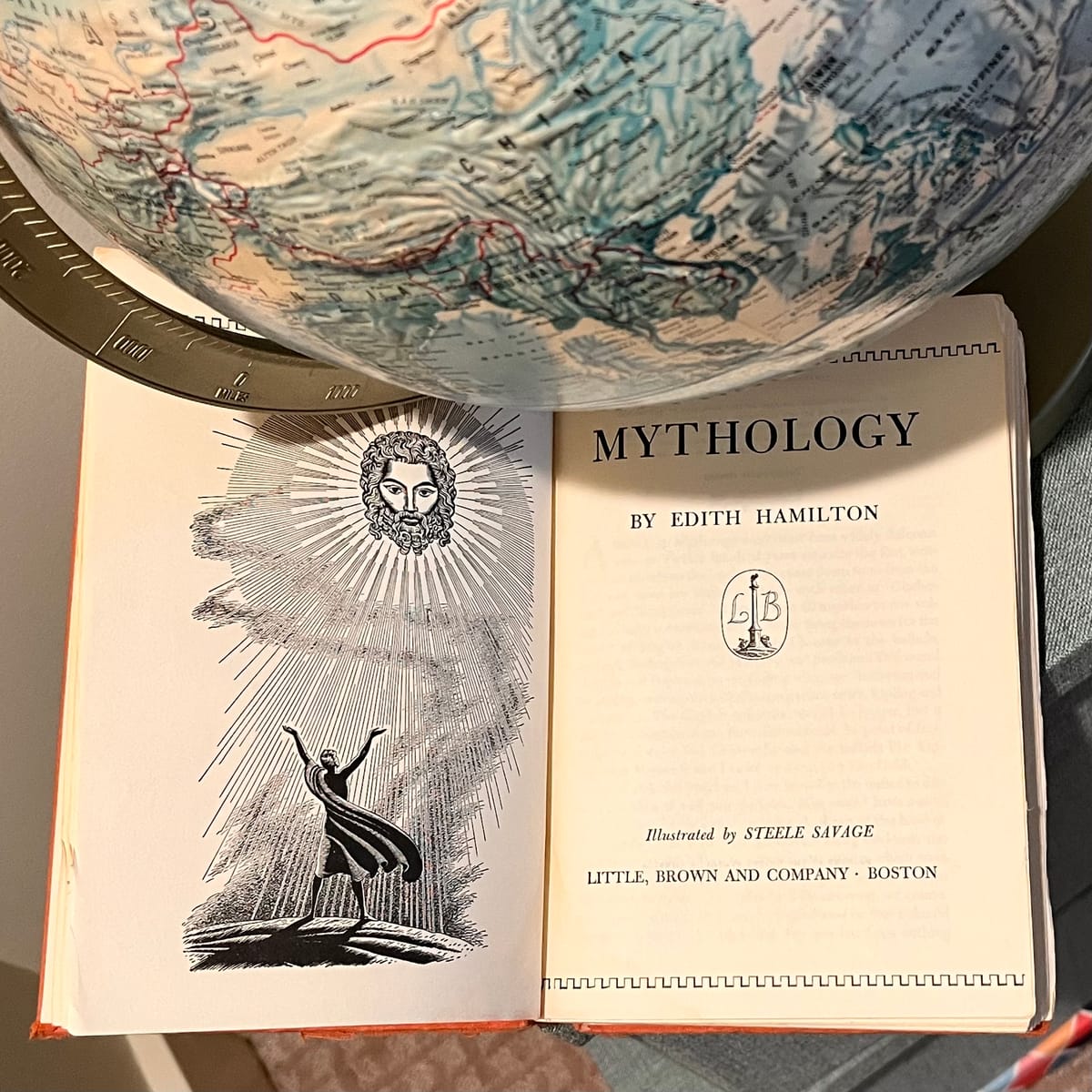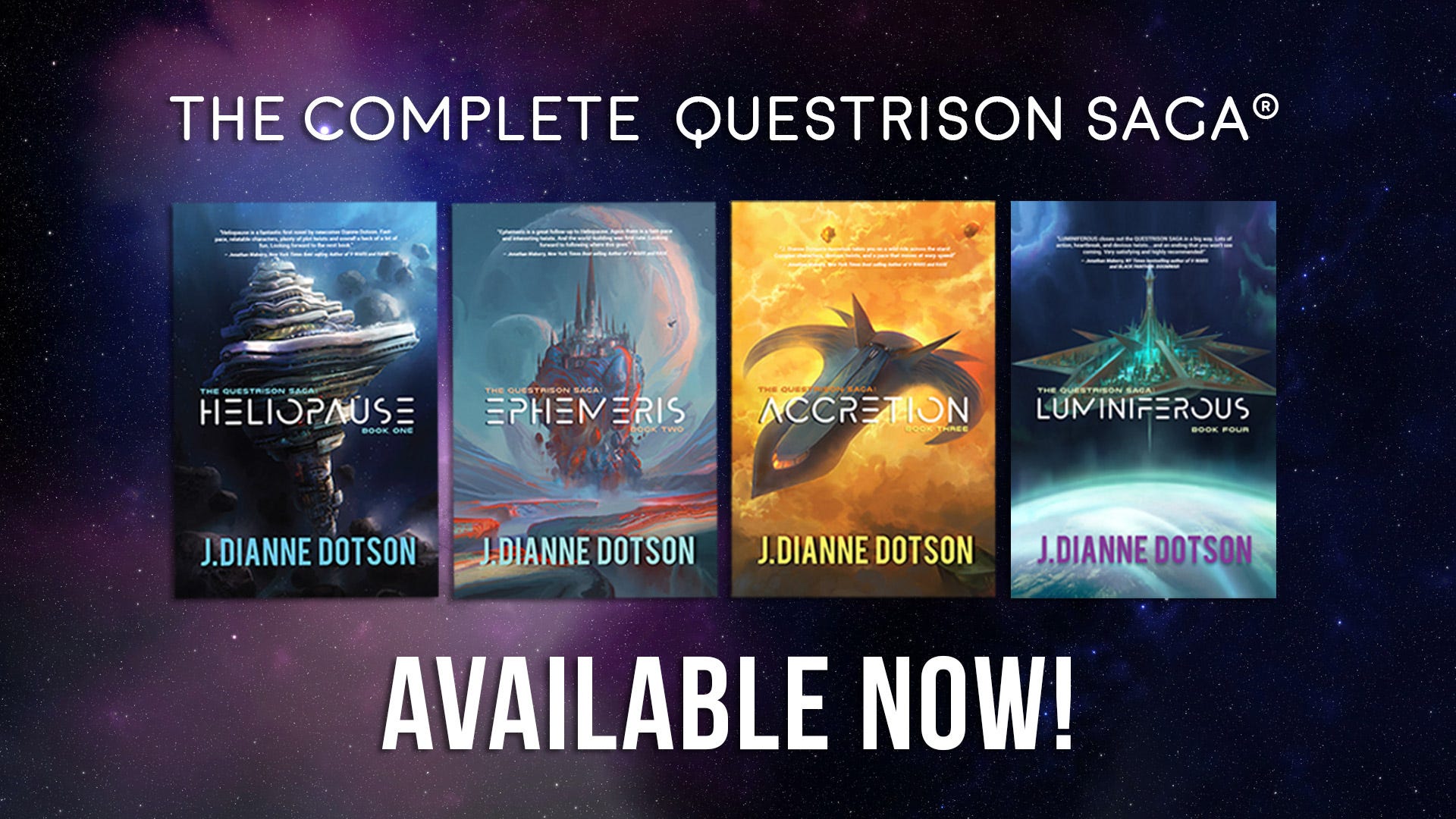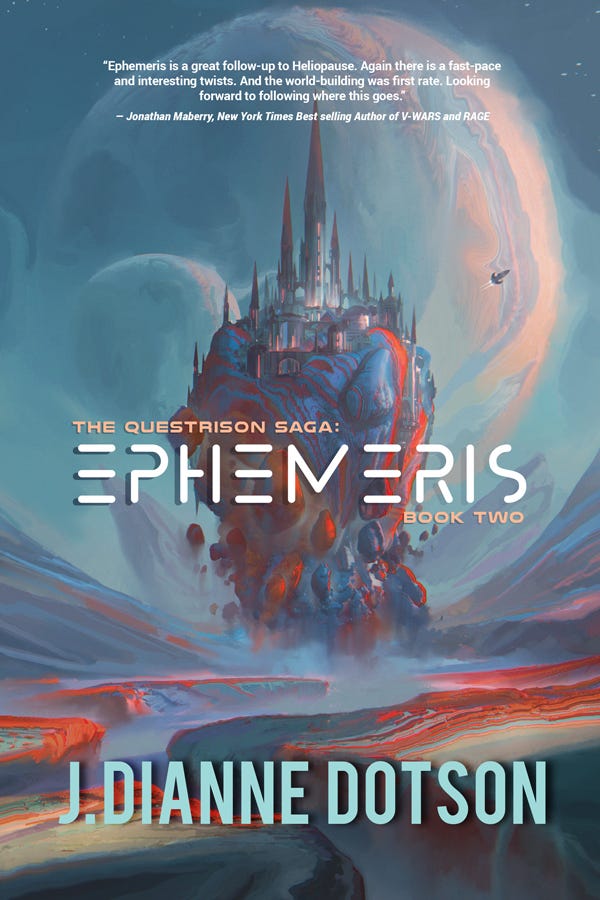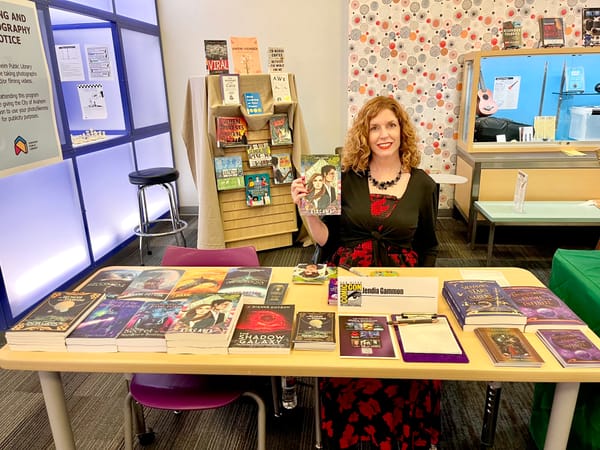Influential Books: MYTHOLOGY by Edith Hamilton
The elements of many of my stories, and my eventual education in Classics, arose directly from this book of my father's.

When I was a little girl, I remember watching the great mythology movies CLASH OF THE TITANS and JASON AND THE ARGONAUTS with my dad. These were of course given grand effects by the stop-motion maestro, Ray Harryhausen. Those films particularly opened me up to Ancient Greek and Roman mythology, and in the case of TITANS, began my obsession with a certain little mechanical owl named Bubo (who I love to illustrate).
I noticed Dad enjoyed reading a hardback copy of a mythology book, and when I was old enough, he let me read it. This is the same copy above, careworn by father and daughter over many decades. After Dad passed away in 2020, I sought to recover this book at some point, and I eventually did. It’s a priceless treasure despite its damaged cover and crinkled pages.
It wasn’t just the myths I enjoyed, although of course I had a fondness for Artemis/Diana, which of course is where my middle name Dianne comes from, an Americanized version of the French Diane. (I like my spelling because it contains the name Anne, but that’s a tale for another influential book…!)
I also truly, madly, deeply loved the illustrations by Steel Savage. These would powerfully influence my character illustrations over the years.
Classical Myth Influence in The Questrison Saga

If you’ve read my epic four-book space opera series, The Questrison Saga, you might have made connections to occasional nods to ancient mythology. But surprisingly, the myth of Galatea is NOT remotely related to my ageless, diamethyst geode-born superhero Galla-Deia, as some people have thought! In fact, I didn't know much about Galatea for many years, and after I had come up with the character and her origin. Galla’s name changed slightly over time, but I settled on Galla-Deia (pronounced GAL-a DAY-a), because it kind of went along with other naming conventions in the book, including the strange, hidden planet Quopeia* (quo-PAY-a).
*You can see Quopeia on the cover of LUMINIFEROUS above.
But I would learn eventually that “deia” meant goddess. Well, that seemed a tad appropriate!
At any rate, the closest parallel to myths and my saga is the relationship between Galla and the galactic mage Aeriod, strongly hinted at in my first book, HELIOPAUSE. But it’s EPHEMERIS, the second novel, where she’s properly introduced. She takes on the saga as its chief character from then on, supported by many side characters, Aeriod among them, as well as several humans whose fates intertwine with Galla’s.

When Galla is introduced, she’s living in a star-city traveling in space, full of androids and no “living” people, helmed by the ancient android Oni-Odi, who serves as her surrogate father after he discovers her geode floating in deep space. After bringing her aboard the star-city, the geode cracks open, and Galla is born fully-formed (rather like Athena from Zeus’s mind) and adult physically. She is, however, a complete naif, and Oni really doesn’t know what to do with her. She looks human but she isn’t; and he doesn’t know any humans. By the way, the name of the star-city is Demetraan.
Oni-Odi decides Galla must be one of the Representatives, ageless beings who resemble species they are supposed to represent and protect. He suggests to the galactic ruling body, the Associates, that Galla should be trained by them, and that she might play a role in fighting the approaching menace, the being Paosh Tohon, hellbent on bending the galaxy to its will. One of the Associates is Aeriod, a bit of a free agent and loner, and Oni-Odi knows the mage’s opinion will hold more sway than others on the council. So Aeriod decides to pay Oni-Odi a visit at Demetraan. And then he meets Galla-Deia…
It’s a charged moment, in which someone much older, with extraordinary power, meets someone incredibly innocent and slightly feral in Galla. But Aeriod also finds her beautiful, and fiery, and in that moment, they both come unmoored a bit. He is all in black with silver hair and silver eyes. She is radiant, with hair almost sentient, drifting all about her, in copper, gold, and violet colors. The moment of their meeting changes the course of galactic history forever, and begins a slow-burn romance. For he wants her all to himself, before any of the other Associates—some of whom are monstrous—can have access to her for training. He takes her personally to his planet Rikiloi*, to his castle perched on a captured asteroid, which he commands to hover about a mile above the planet’s surface. Then he begins her training, but it is very much a MY FAIR LADY and THE SOUND OF MUSIC scenario of a May-December relationship between an older man and a headstrong young woman. Finally, Aeriod, acerbic and lonely, has another ageless companion, and he would give Galla the universe if she would stay with him.
*Rikiloi is seen on the cover of EPHEMERIS above.
Galla, however, is ferociously independent, and quickly learns that she wants something different from her life, even as she’s essentially clueless.
If you’ve not already guessed, here are the nods: Demetraan = Demeter, Galla-Deia = Persephone, and Aeriod = Hades. This myth would also arise again later in the series, but I’m not going to spoil the how or who of that.
I always loved the myth of Persephone symbolizing Spring, and so I wanted to lean into that in my space opera. I owe Edith Hamilton’s collected ancient myths for that.
Eta Sigma Phi
But the book MYTHOLOGY would shape my university education also! I hold a degree in Ecology and Evolutionary Biology, but as part of my degree requirement, I needed certain courses in language, sociology, and more, and I found the perfect entry via Classics. I took Latin, eventually translating Virgil’s AENEID, as well as Ancient Greek and Roman architecture, and other Classics-based courses. I did well enough in Latin that my professor inducted me into Eta Sigma Phi, the Classics Honor Society, whose mascot is an owl.
You’ll see more owls in my future works as well…
As you can see, this one book helped shaped many more words throughout my life. It was also a point of bonding between me and Dad, and we talked about the myths a lot over the years. They also helped fuel my love for astronomy and the cosmos writ large, as finding constellations in the night sky gave me much joy in my East Tennessee youth, and still does, here out West.
It’s amazing just how far the influences of books can take our imaginations. From worn pages to galactic mages, MYTHOLOGY looms large in the pantheon of my mind.
Write on!
Jendia




